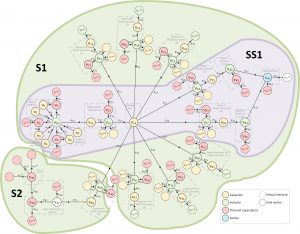- Curriculum Vitae
- ddocimo@illinois.edu
- Ph.D. – The Pennsylvania State University, 2017
- M.S. – The Pennsylvania State University, 2015
- B.S. – The College of New Jersey, 2012
- Research Interests: hierarchical control, design optimization, electro-thermal systems, electric vehicles (EVs), batteries, building energy systems
Donald Docimo, Ph.D. conducts research in the area of advanced, model-based control and design as applied to energy systems. His focus is use of tools from control, model reduction, optimization, and estimation theory to address major challenges in applications that span electrified vehicles, aircraft, and advanced thermal management devices. He is an experienced educator, having instructed junior- and senior-level controls courses, developed online multimedia courses, and mentored students.
Current Research
Research supported by:
- The National Science Foundation Engineering Research Center for Power Optimization of Electro-Thermal Systems (POETS)
- The Center for Integrated Thermal Management of Aerospace Vehicles (CITMAV)
Ongoing work includes extensions of hierarchical control strategies for energy management, system design optimization, and testbed development to validate electro-thermal device performance. Electrification of mobile power systems is a megatrend motivated by desired trends of increased energy diversification, global greenhouse gas reduction, and reduced fuel costs. However, current benefits are partially neutralized by challenges associated with integration of new components with existing technology. Integration challenges are directly tied to heterogeneity within these energy systems. Heterogeneity of components, timescales (slow vs. fast), and their domains (electrical, thermal, etc.) instigates new plant and controller design challenges. In particular, current generation thermal management systems face hardship in dealing with these complex, heterogeneous power systems, leading to increased component degradation, defects, and insufficient control.
My current research efforts address the challenges of electrification integration in the following ways:
Graph-based modeling and system decomposition. Complex, multi-domain systems can be represented by modular graph-based models using the conservation of energy. This research extends these graph-based models from thermal components to include advanced electrical and mechanical components. Applying this to an electric vehicle powertrain (Figure 1), a graph-based model representing electrical, thermal, and mechanical power flows can be quickly determined. A novel energy-based system decomposition method allows the partitioning of this vehicle model into system and subsystem layers (Figure 2).
Hierarchical control. The variety in dynamic timescales within electro-thermal systems creates computational and accuracy challenges for centralized and decentralized controllers. Hierarchical control has been recognized as a powerful tool to improve the management of these electro-thermal interactions. Use of a hierarchical control framework (Figure 3) permits top-down management of the components of the EV while reducing computation time as compared to algorithms such as centralized control. Using the decomposed hierarchy, a hierarchical control algorithm can be easily developed by applying model predictive control (MPC) to each layer of the controller. This yields a more tightly controlled vehicle that provides increased available power while keeping components within thermal constraints. Figure 4 shows how an EV hierarchical control algorithm is able to avoid massive thermal constraint violations while tracking desired qualities such as vehicle velocity.

Figure 4. (a) Velocity and (b) converter temperature during an acceleration phase. (c) Comparison of subsystem, system and vehicle level duty cycle inputs for converters 5 and 6 during this phase.
Plant design. Design optimization can be used to mitigate integration of electrical components into mobile power systems at early stages. Graph-based models are used to develop industry-friendly tools to perform simultaneous component sizing and topology optimization for complex, multi-domain systems with reduced setup and solution times. Figure 5 presents an example of the graph-based design tool applied to a complex, multi-domain vehicular system.

Figure 5. Graph-based sizing and topology design optimization for a complex, multi-domain vehicle architecture.
Previous Research
Battery systems. For the purpose of improving EV reliability and cost, it is ideal to remove heterogeneity between battery cells in order to extend pack lifespan. State (charge, temperature) and parameter (health) heterogeneity between battery cells within a battery pack is known to increase degradation of all cells and reduce pack capabilities. My research uses physics-based battery cell models and control theory to determine fundamental trade-offs between balancing charge (benefits short-term performance) vs. balancing capacity or temperature (benefits long-term lifespan). This information is used to develop control algorithms which manage these trade-offs and balance heterogeneity only by shuttling charge, yielding a 10% increase in pack lifespan.
Building energy systems. My research provides insights into how the electrical air conditioning (AC) system impacts energy stored with the building’s thermal capacitance for demand response. Analytic, characteristic damping ratios are determined to quantify the oscillations in aggregate power demanded by a population of heterogeneous building energy systems after a demand response event. These damping ratios can be used to perform population design, and develop demand response control algorithms.
Publications (Journal)
- D.J. Docimo, Z. Kang, K.A. James, and A.G. Alleyne, “A Novel Framework for Simultaneous Topology and Sizing Optimization of Complex, Multi-Domain Systems-of-Systems,” (in preparation).
- D.J. Docimo and H.K. Fathy, “Analysis and Control of Charge and Temperature Imbalance Within a Lithium-Ion Battery Pack,” IEEE Transactions on Control System Technology, 2018.
- D.J. Docimo and H.K. Fathy, “Demand Response Using Heterogeneous Thermostatically Controlled Loads: Characterization of Aggregate Power Dynamics,” J. of Dynamic Systems, Measurement, and Control, vol. 139, no. 10, pp. 101009, 2017.
- D.J. Docimo, M. Ghanaatpishe, and A. Mamun, “Extended Kalman Filtering to Estimate Temperature and Irradiation for Maximum Power Point Tracking of a Photovoltaic Module,” Energy, vol. 120, pp. 47-57, 2017.
- D.J. Docimo and H.K. Fathy, “Multivariable State Feedback Control as a Foundation for Lithium-Ion Battery Pack Charge and Capacity Balancing,” J. of the Electrochemical Society, vol. 164, no. 2, pp. A61-A70, 2017.
- M.J. Rothenberger, D.J. Docimo, M. Ghanaatpishe, and H.K. Fathy, “Genetic Optimization and Experimental Validation of a Test Cycle that Maximizes Parameter Identifiability for a Li-Ion Equivalent-Circuit Battery Model,” J. of Energy Storage, vol. 4, pp. 156-166, 2015.
Publications (Magazine)
- D.J. Docimo, M. Ghanaatpishe, M.J. Rothenberger, C.D. Rahn, and H.K. Fathy, “The Lithium-Ion Battery Modeling Challenge: A Dynamic Systems and Control Perspective,” Dynamic Systems and Control Mag., vol. 136, no. 6, pp. 7-14, June, 2014.
Publications (Conference)
- P.J. Tannous, D.J. Docimo, H.C. Pangborn, and A.G. Alleyne, “Hierarchical Estimation for Complex Multi-Domain Dynamical Systems,” in 2019 American Control Conf., 2019 (submitted).
- D.J. Docimo, H.C. Pangborn, and A.G. Alleyne, “Hierarchical Control for Electro-Thermal Power Management of an Electric Vehicle Powertrain,” in ASME 2018 Dynamic Systems and Control Conf., 2018.
- D.J. Docimo and A.G. Alleyne, “Electro-Thermal Graph-Based Modeling for Hierarchical Control with Application to an Electric Vehicle,” in IEEE Conference on Control Technology and Applications, 2018.
- D.J. Docimo and H.K. Fathy, “Using a Linear Quadratic Regulator to Attenuate Cell-to-Cell Heterogeneity within a Lithium-Ion Battery Pack,” in IEEE Conference on Control Technology and Applications, 2018.
- D.J. Docimo and H.K. Fathy, “Characterization of Damping and Beating Effects Within the Aggregate Power Demand of Heterogeneous Thermostatically Controlled Loads,” in ASME 2015 Dynamic Systems and Control Conf., 2015.
- D.J. Docimo, M. Ghanaatpishe, and A. Mamun, “Feedback-Based Temperature and Irradiation Estimation for Photovoltaic Modules,” in ASME 2015 Dynamic Systems and Control Conf., 2015.
- D. Docimo, M. Ghanaatpishe, and H. K. Fathy, “Development and Experimental Parameterization of a Physics-Based Second-Order Lithium-Ion Battery Model,” in ASME 2014 Dynamic Systems and Control Conf., 2014.



